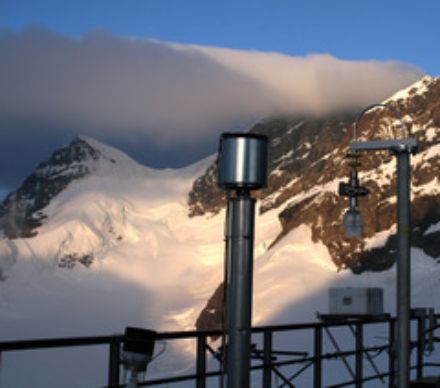Service Navigation
Search
The Paul Scherrer Institute (PSI) takes aerosol measurements on a continuous basis at the Jungfraujoch high-altitude research station on behalf of MeteoSwiss. The measurement data form part of Switzerland’s contribution to the Global Atmosphere Watch (GAW) programme established by the World Meteorological Organisation (WMO). Long-term quality monitoring and long-term trend analysis are performed in close collaboration with the MeteoSwiss aerological station in Payerne.
Keeping track of minute particles
The continuous measurement of aerosols is carried out with the help of sampling heads, looking at the following parameters:
- The optical properties of the aerosols (absorption, scattering and backscattering as well as their wavelength dependences)
- The number concentration of particles of cloud condensation nuclei allowing the formation of clouds
- Particle size after distribution
- Chemical composition of the particles
Important climate parameters such as the extinction, single scattering albedo and asymmetry parameters can be then calculated. For example, the simple scattering albedo value determines the sign of the radiative forcing due to aerosols, and its wavelength dependence allows the detection of Saharan dust incursions.

Measurement of aerosols in the atmosphere
MeteoSwiss also analyses and observes aerosols by means of remote sensing instruments that provide vertical profiles of certain aerosol parameters, and instruments that measure the entire atmospheric column. Aerosol optical depth is measured at stations that form part of the Swiss Alpine Climate Radiation Monitoring (SACRaM) network. It is a measure of the opacity of the atmosphere and indicates the degree to which airborne particles prevent the transmission of light. Optical depth is an important radiative forcing variable on earth.
The profiles of aerosol backscattering are measured by LiDAR (Light Detection and Ranging) sensors at the MeteoSwiss aerological station in Payerne, allowing researchers to estimate the aerosol concentration as a function of altitude up to 12 km. LiDAR are high-performance instruments designed for the analysis of particular climatic conditions. Aerosol mass concentration data are used for monitoring air quality: the measurement station in Payerne forms part of the national network for the observation of atmospheric pollutants (NABEL) operated jointly by the Federal Office for the Environment (FOEN) and the Swiss Federal Laboratories for Materials Science and Research (EMPA).
